Disclaimer: This website contains affiliate links, from which Heritage Acres Market LLC may receive a small commission from the vendor on the sales of certain items, all at no cost to you. Please read our full disclosure for more information. Thank you for supporting Heritage Acres Market LLC!
The Leghorn chicken breed has many wonderful attributes that make it the perfect fit for any backyard flock: High volume white egg production, excellent fertility, good health and hardiness, chicks that are easy to raise and quick to feather, and they are heat and cold tolerant. The Leghorn breed was immortalized in the 1940s to 1960s by the famous Leghorn rooster cartoon character Foghorn Leghorn.
Is the right for your flock?
- Leghorn chickens are prolific layers of large white eggs
- They are heat and cold tolerant
- Not the best chicken for beginners or children
Table of Contents
Background & History of the Breed
The Leghorn chicken comes from the port of Livorno in Tuscany, Northern Italy, and was known initially as the Livornese. The name was then anglicized to Leghorn.
The Leghorn breed found its way to America in 1852 aboard the ship of Captain Gates, which docked at Mystic harbor in Connecticut. These first chickens were brown in color. The following year F.J. Kinney received more Brown Leghorns, and Mr. Simpson (later treasurer of the New York State Poultry Society) took a shipment of White Leghorn chicken at Boston Harbor.
The birds were immediately popular, and some were then exported to England, where white Leghorns were purchased by Mr. Tegetmeier in 1870 and then the Brown Leghorn chicken by Lewis Wright in 1872.
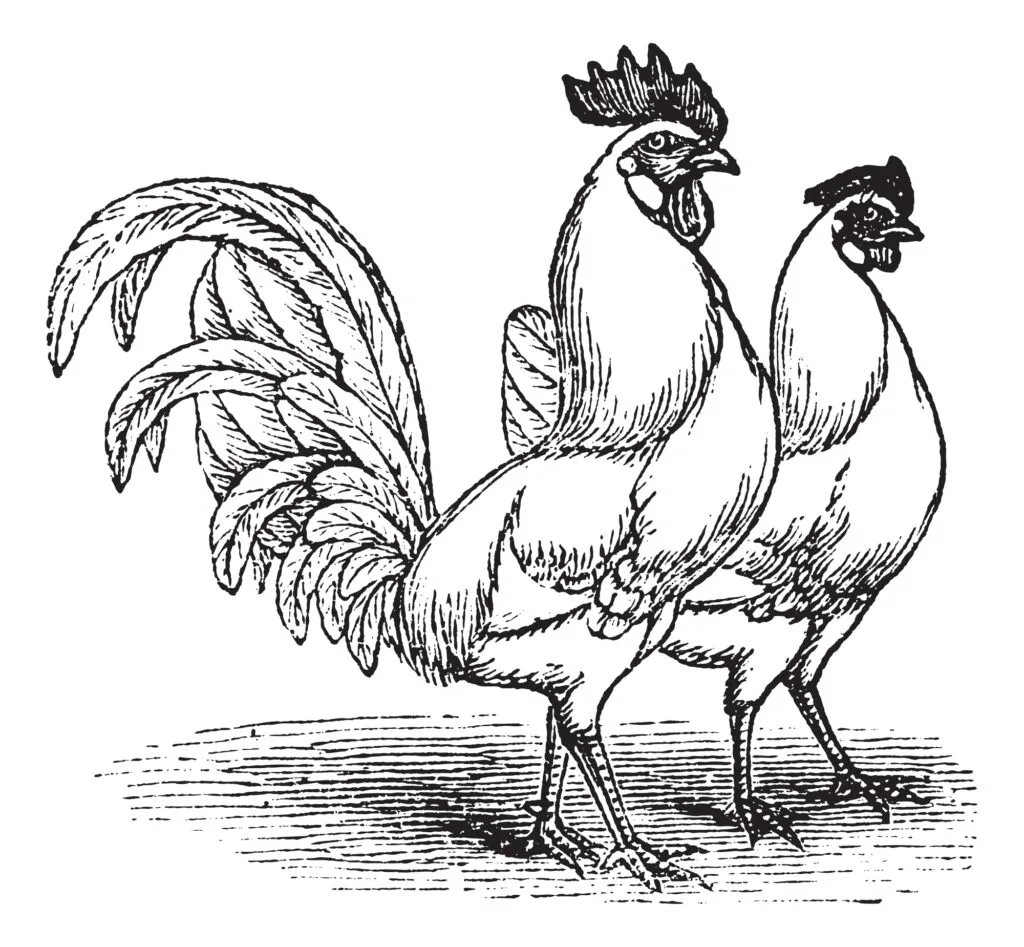
The breed found some favor in England due to its egg-laying ability, but even though the birds were thrifty with their food intake, they were not fully embraced. This was primarily because the chickens were small and of no actual use for meat.
Some of the chickens were crossed with Minorcas to increase their size and make them better dual-purpose fowl to overcome this. These hybridized English Leghorns were then shipped back to America. The result was the beginning of developing two distinct types of Leghorn; the industrial hybrid, which was used for commercial egg production, and the non-industrial type, which remained closer to the original fowl imported from Italy.
The non-industrial birds retained their foraging abilities and were favored by small farm and backyard breeders. In parallel, the industrial type of birds became popular for commercial white egg production from about 1910 onwards and dominated the market throughout the United States.
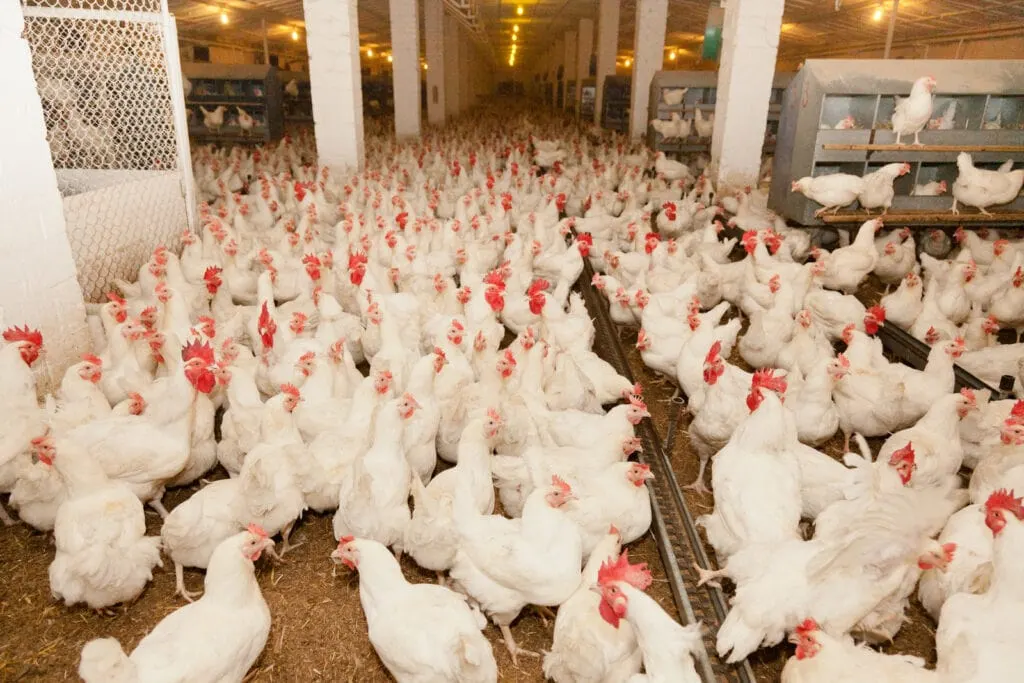
As to the Leghorn chicken being a heritage breed, the non-industrial birds indeed fit the bill, but the jury is out for now on the highly developed industrial Leghorns.
Frank Reese from Good Shepherd Conservancy said that, “True heritage birds must be of a breed that existed before 1950, must not be hybridized, and they must breed naturally. Some chickens touted as heritage, such as those found in hatchery catalogs, don’t fit those standards”.
The non-industrial Leghorns are seeing a rise in popularity again with the increase of backyard chicken keeping. This has taken them from being threatened with extinction to placement on the recovering list.
Today’s commercial Leghorns have been radically changed through hybridization. As a result, they are almost unrecognizable to the original Leghorn that served so well to provide eggs and even meat for hundreds of years. In this article, we are therefore going to be referring to the traditional non-industrial Leghorns.
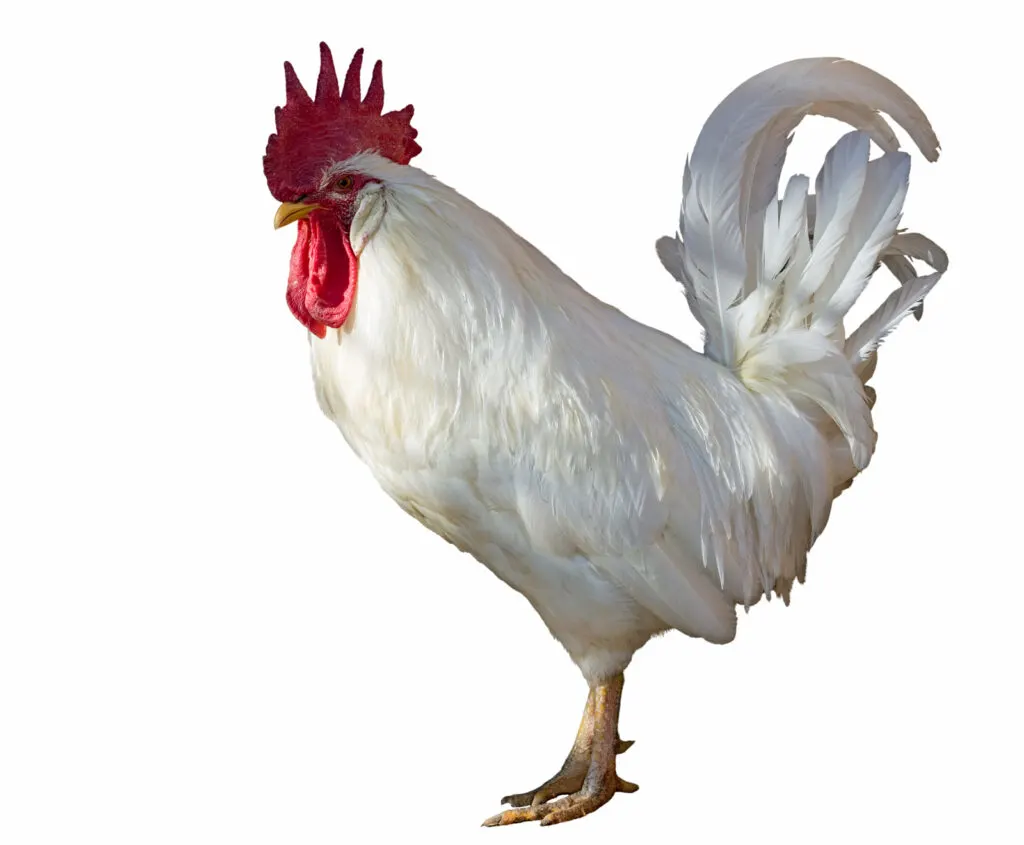
Temperament Behavior and Personality
The Leghorn chicken is an active, intelligent, and resourceful bird. They forage almost continually, scratching around and hunting for tasty treats. Despite being excellent foragers, they are small eaters and can produce a prolific number of eggs on a minimal amount of feed.
They retain an excellent flying ability, can be highly strung, and have a reputation for being quite noisy, making them unsuitable for an urban chicken keeper.
Their intelligence sometimes acts against them, as they are quickly bored if kept enclosed. This makes them better suited to free-ranging or living in very large chicken coops with plenty of entertainment in the form of chicken toys.
Although some people say their Leghorn pullet is the friendliest chickens they have ever had, they are better known as somewhat aloof and shunning human interaction.
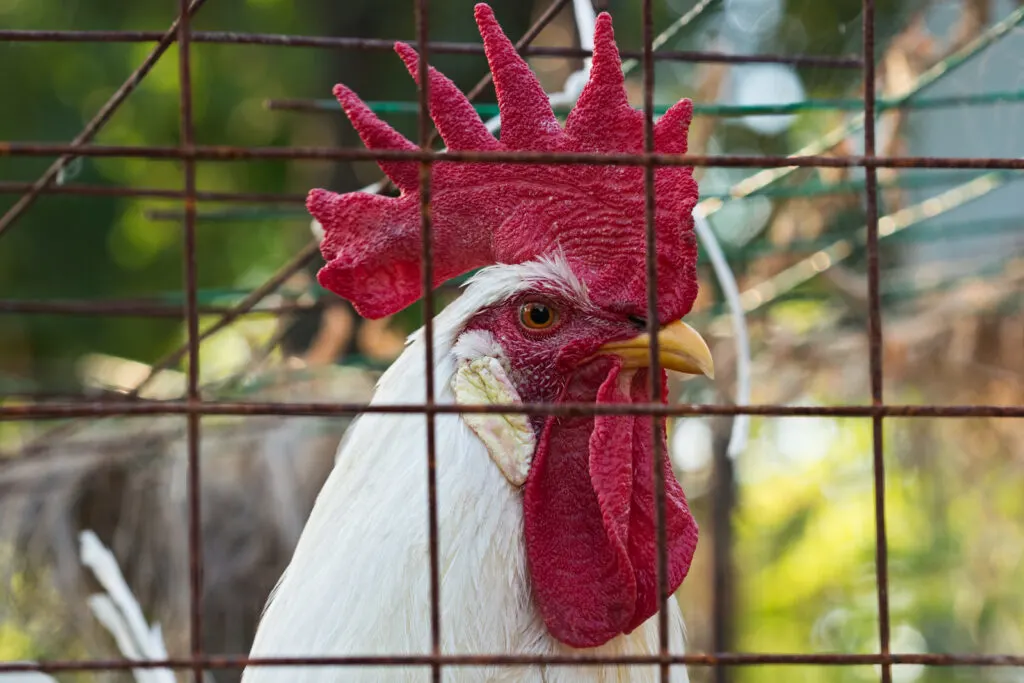
If you want birds that are easy to hold, the best way is to raise them from chicks and get them used to frequent handling. It is unlikely, however, that they will ever become lap chickens.
Overall, this means Leghorns don’t make the best pet chicken for kids. However, they can be a good option for beginners if the main aim is high egg production because they are incredibly hardy, easy to keep birds.
Leghorns don’t tend to go broody and typically make poor mothers. It is best to hatch eggs yourself with an incubator or give the job to a more amenable chicken breed such as a Buff Orpington.
The non-industrial Leghorn varieties are flighty but generally not aggressive if kept free-range with plenty of space. However, problems can sometimes develop if they are kept with other chicken breeds in a chicken coop.
The industrial type of Leghorn is known for its aggression. For these reasons, it is better to keep only Leghorns together or, if you are going to mix them with other chickens, to ensure that they are equally matched. Avoid very docile, low-energy coop mates.
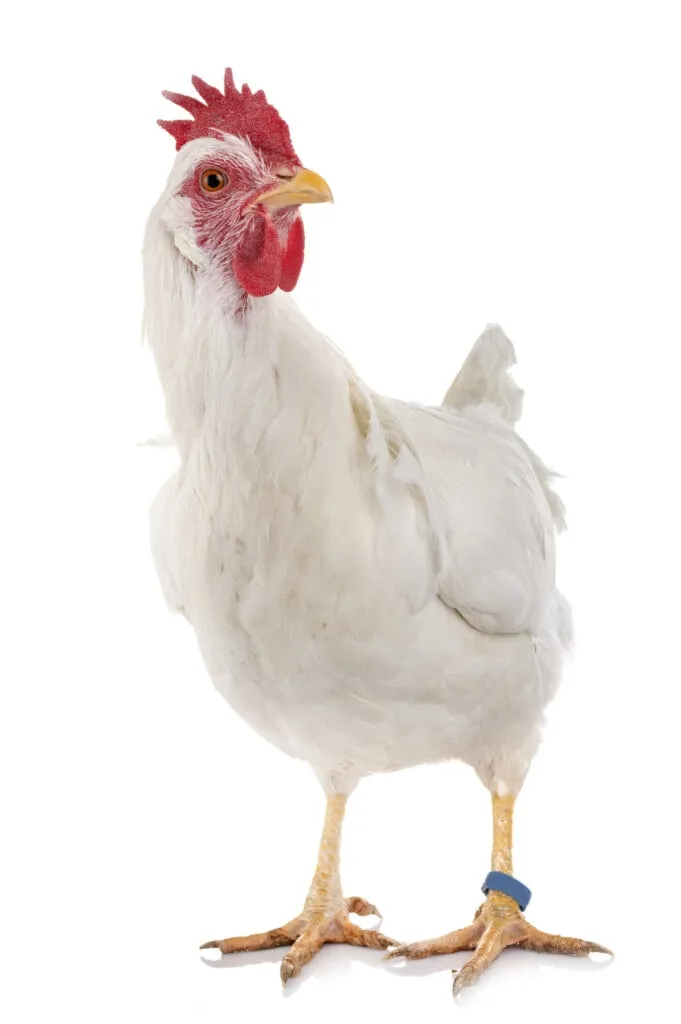
Breed Specifics and Traits
Leghorn chickens are egg-laying birds of the Mediterranean class that reach maturity in 18 to 20 weeks. Males weigh in at around 6 lbs, while the hen averages 4.5 lbs, although weight can vary with the type. Leghorn bantams are about 2.2 lbs for males and 1.9 lbs for females.
Because they are such a prolific egg-laying breed, a Leghorn hen tends to live shorter lives than many other types of chicken. On average, a laying hen will only live for about 4 to 6 years.
They are quite game-like in appearance, being narrow-breasted with an upright stance. They are sleek, long, and aerodynamic.
The comb comes in two varieties, either a red colored single comb or a rose comb. The single comb type has a surprisingly large comb which can appear rather comical compared to the bird’s size. The rose comb is better for cold locations, as it is less susceptible to frostbite.
The wattles are red, and they have white earlobes and orange or red eyes. The beak is yellow, as are their skin and legs. They have four toes, are clean legged and can have spurs.
The American Poultry Association admitted the following standards of Leghorn chickens as follows:
- 1874 – Single Comb Light Brown, Single Comb Dark Brown, Single Comb White, Single Comb Black.
- 1883 – Rose Comb Light Brown, Rose Comb Dark Brown.
- 1886 – Rose Comb White.
- 1894 – Single Comb Buff Leghorn, Single Comb Silver
- 1929 – Single Comb Red, Single Comb Black-Tailed Red, Single Comb Columbian.
- 1981 – Rose Comb Black, Rose Comb Buff, Rose Comb Silver, Single Comb Golden Duckwing.
There are also other Leghorn color varieties that the American Poultry Association does not accept. These include the silver duckwing, Isabella, partridge, and exchequer leghorn.
Leghorns rarely hatch chicks, but those raised using an incubator, or a broody hen, mature quickly and feather up fast. The Leghorn chick’s coloring will depend on the color of the parent bird. For example, white Leghorn chicks are born yellow, while brown Leghorn chicks are brown and yellow.
Being a Mediterranean class bird, Leghorns tolerate heat well. They are very hardy and will also cope with cold climates. As with other types of chickens, it is essential to provide them with adequate, well-insulated housing that shelters them from the heat in summer and the cold in winter.
They are good at evading predators, being flighty, and easy to startle. Ensuring they are safely tucked up in their coop at night will help to prevent them from becoming victims to nighttime attacks while they roost.
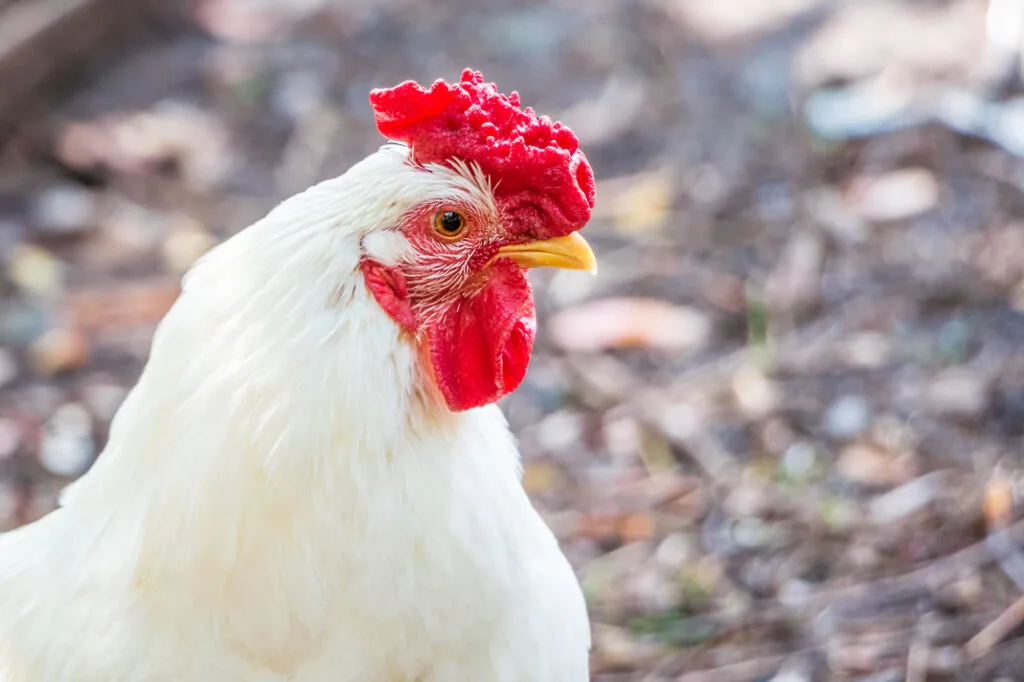
Health Issues
The Leghorn chicken is a robust and active chicken breed with no particular health concerns other than frostbite of their combs in winter. The rose comb varieties do not suffer so much from this problem.
They will require routine treatments against lice, mites, and worms, just as other chicken breeds do.
Eggs
A Leghorn pullet will typically start laying eggs between 24 and 30 weeks of age. All Leghorn varieties lay a large white egg that weighs around 2 ounces. It is common for the already large egg to get larger as the chicken ages.
Depending on the variety of Leghorn you have, they can lay between 150 to 320 large eggs in a year. The commercial White Leghorn hen will commonly lay for 10 to 12 weeks longer than other chicken breeds and continue to lay well into their third and fourth years.

Leghorn Chicken Overview
| Type | Egg Production |
| Size | Medium to large |
| Heritage Breed | Yes |
| Average Weight | Rooster 6 lbs, hen 4.5 lbs |
| Weeks To Maturity | 18 to 20 weeks |
| Average Life Span | 4 to 6 years |
| Color variations | American Poultry Association recognizes: Single Comb Light Brown, Single Comb Dark Brown, Single Comb White, Single Comb Black, Rose Comb Light Brown, Rose Comb Dark Brown, Rose Comb White, Single Comb Buff, Single Comb Silver, Single Comb Red, Single Comb Black-Tailed Red, Single Comb Columbian, Rose Comb Black, Rose Comb Buff, Rose Comb Silver, Single Comb Golden Duckwing. |
| Egg Size | Large to Extra Large |
| Egg Color | White |
| Egg Production | 150 to 320 per year |
| Dual Purpose | Not a true dual purpose bird |
| Temperament | Flighty and nervous |
| Beginner Friendly | Not ideal |
| Kid Friendly | Not ideal |
| Heat Tolerant | Yes |
| Cold Tolerant | Yes if comb protected |
| Comb Type | Single or rose |
| Broodiness | Not broody |
| Flightiness | Can fly well |
| Noise Level | High |
| Unique Traits | Maintains egg production longer than many other breeds |
Where to Buy Leghorns
One of the best ways to buy chicks or fertile eggs is by looking at advertisements in your local area. That way, you won’t need to have them mailed to you. They can be found by looking on eBay, Amazon, or Craigslist as well as in local farm stores.
Another way to get chicks or fertile eggs is by buying from a hatchery.
Cackle Hatchery offers White or Brown Leghorn Chicks and hatching eggs. Chicks start at $1.95 with a minimum order of 3 chicks. Hatching eggs are priced at 12 eggs for $54.36 ($4.53 per egg) or 24 eggs for $90.24 ($3.76 per egg)
Cackle Hatchery is our preferred and recommended hatchery. While most hatcheries require orders of at least 25 chicks, you can buy as few as 3 chicks from Cackle. They are also highly rated on Google and have been in business since 1936.
Summary
If you’re looking for prolific egg layers with a small appetite that is typically healthy and low maintenance, the Leghorn may be the chicken for you.
They thrive as free-range birds and enjoy foraging, but they don’t go broody or raise young well.
Their alert, active nature means they are good at avoiding predators, but it also means they aren’t the most affectionate of chickens and are not the best choice for children or beginners.
